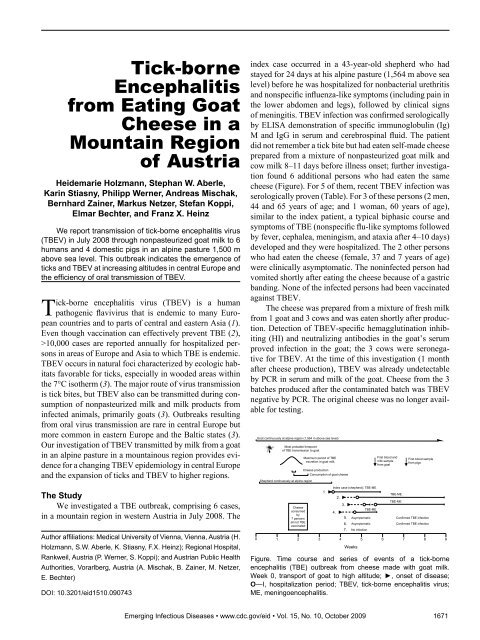Tick-borne Encephalitis from Eating Goat Cheese in a Mountain ...
Tick-borne Encephalitis from Eating Goat Cheese in a Mountain ...
Tick-borne Encephalitis from Eating Goat Cheese in a Mountain ...
Create successful ePaper yourself
Turn your PDF publications into a flip-book with our unique Google optimized e-Paper software.
<strong>Tick</strong>-<strong>borne</strong><br />
<strong>Encephalitis</strong><br />
<strong>from</strong> <strong>Eat<strong>in</strong>g</strong> <strong>Goat</strong><br />
<strong>Cheese</strong> <strong>in</strong> a<br />
Mounta<strong>in</strong> Region<br />
of Austria<br />
Heidemarie Holzmann, Stephan W. Aberle,<br />
Kar<strong>in</strong> Stiasny, Philipp Werner, Andreas Mischak,<br />
Bernhard Za<strong>in</strong>er, Markus Netzer, Stefan Koppi,<br />
Elmar Bechter, and Franz X. He<strong>in</strong>z<br />
We report transmission of tick-<strong>borne</strong> encephalitis virus<br />
(TBEV) <strong>in</strong> July 2008 through nonpasteurized goat milk to 6<br />
humans and 4 domestic pigs <strong>in</strong> an alp<strong>in</strong>e pasture 1,500 m<br />
above sea level. This outbreak <strong>in</strong>dicates the emergence of<br />
ticks and TBEV at <strong>in</strong>creas<strong>in</strong>g altitudes <strong>in</strong> central Europe and<br />
the efficiency of oral transmission of TBEV.<br />
<strong>Tick</strong>-<strong>borne</strong> encephalitis virus (TBEV) is a human<br />
pathogenic flavivirus that is endemic to many European<br />
countries and to parts of central and eastern Asia (1).<br />
Even though vacc<strong>in</strong>ation can effectively prevent TBE (2),<br />
>10,000 cases are reported annually for hospitalized persons<br />
<strong>in</strong> areas of Europe and Asia to which TBE is endemic.<br />
TBEV occurs <strong>in</strong> natural foci characterized by ecologic habitats<br />
favorable for ticks, especially <strong>in</strong> wooded areas with<strong>in</strong><br />
the 7°C isotherm (3). The major route of virus transmission<br />
is tick bites, but TBEV also can be transmitted dur<strong>in</strong>g consumption<br />
of nonpasteurized milk and milk products <strong>from</strong><br />
<strong>in</strong>fected animals, primarily goats (3). Outbreaks result<strong>in</strong>g<br />
<strong>from</strong> oral virus transmission are rare <strong>in</strong> central Europe but<br />
more common <strong>in</strong> eastern Europe and the Baltic states (3).<br />
Our <strong>in</strong>vestigation of TBEV transmitted by milk <strong>from</strong> a goat<br />
<strong>in</strong> an alp<strong>in</strong>e pasture <strong>in</strong> a mounta<strong>in</strong>ous region provides evidence<br />
for a chang<strong>in</strong>g TBEV epidemiology <strong>in</strong> central Europe<br />
and the expansion of ticks and TBEV to higher regions.<br />
The Study<br />
We <strong>in</strong>vestigated a TBE outbreak, compris<strong>in</strong>g 6 cases,<br />
<strong>in</strong> a mounta<strong>in</strong> region <strong>in</strong> western Austria <strong>in</strong> July 2008. The<br />
Author affiliations: Medical University of Vienna, Vienna, Austria (H.<br />
Holzmann, S.W. Aberle, K. Stiasny, F.X. He<strong>in</strong>z); Regional Hospital,<br />
Rankweil, Austria (P. Werner, S. Koppi); and Austrian Public Health<br />
Authorities, Vorarlberg, Austria (A. Mischak, B. Za<strong>in</strong>er, M. Netzer,<br />
E. Bechter)<br />
DOI: 10.3201/eid1510.090743<br />
<strong>in</strong>dex case occurred <strong>in</strong> a 43-year-old shepherd who had<br />
stayed for 24 days at his alp<strong>in</strong>e pasture (1,564 m above sea<br />
level) before he was hospitalized for nonbacterial urethritis<br />
and nonspecific <strong>in</strong>fluenza-like symptoms (<strong>in</strong>clud<strong>in</strong>g pa<strong>in</strong> <strong>in</strong><br />
the lower abdomen and legs), followed by cl<strong>in</strong>ical signs<br />
of men<strong>in</strong>gitis. TBEV <strong>in</strong>fection was confirmed serologically<br />
by ELISA demonstration of specific immunoglobul<strong>in</strong> (Ig)<br />
M and IgG <strong>in</strong> serum and cerebrosp<strong>in</strong>al fluid. The patient<br />
did not remember a tick bite but had eaten self-made cheese<br />
prepared <strong>from</strong> a mixture of nonpasteurized goat milk and<br />
cow milk 8–11 days before illness onset; further <strong>in</strong>vestigation<br />
found 6 additional persons who had eaten the same<br />
cheese (Figure). For 5 of them, recent TBEV <strong>in</strong>fection was<br />
serologically proven (Table). For 3 of these persons (2 men,<br />
44 and 65 years of age; and 1 woman, 60 years of age),<br />
similar to the <strong>in</strong>dex patient, a typical biphasic course and<br />
symptoms of TBE (nonspecific flu-like symptoms followed<br />
by fever, cephalea, men<strong>in</strong>gism, and ataxia after 4–10 days)<br />
developed and they were hospitalized. The 2 other persons<br />
who had eaten the cheese (female, 37 and 7 years of age)<br />
were cl<strong>in</strong>ically asymptomatic. The non<strong>in</strong>fected person had<br />
vomited shortly after eat<strong>in</strong>g the cheese because of a gastric<br />
band<strong>in</strong>g. None of the <strong>in</strong>fected persons had been vacc<strong>in</strong>ated<br />
aga<strong>in</strong>st TBEV.<br />
The cheese was prepared <strong>from</strong> a mixture of fresh milk<br />
<strong>from</strong> 1 goat and 3 cows and was eaten shortly after production.<br />
Detection of TBEV-specific hemagglut<strong>in</strong>ation <strong>in</strong>hibit<strong>in</strong>g<br />
(HI) and neutraliz<strong>in</strong>g antibodies <strong>in</strong> the goat’s serum<br />
proved <strong>in</strong>fection <strong>in</strong> the goat; the 3 cows were seronegative<br />
for TBEV. At the time of this <strong>in</strong>vestigation (1 month<br />
after cheese production), TBEV was already undetectable<br />
by PCR <strong>in</strong> serum and milk of the goat. <strong>Cheese</strong> <strong>from</strong> the 3<br />
batches produced after the contam<strong>in</strong>ated batch was TBEV<br />
negative by PCR. The orig<strong>in</strong>al cheese was no longer available<br />
for test<strong>in</strong>g.<br />
<strong>Goat</strong> cont<strong>in</strong>uously at alp<strong>in</strong>e region (1,564 m above sea level)<br />
Most probable timepo<strong>in</strong>t<br />
of TBE transmission to goat<br />
Shepherd cont<strong>in</strong>uously at alp<strong>in</strong>e region<br />
<strong>Cheese</strong><br />
consumed<br />
by<br />
7 persons<br />
all not TBE<br />
vacc<strong>in</strong>ated<br />
Maximum period of TBE<br />
excretion <strong>in</strong> goat milk<br />
<strong>Cheese</strong> production<br />
Consumption of goat cheese<br />
Index case (shepherd): TBE-ME<br />
Emerg<strong>in</strong>g Infectious Diseases • www.cdc.gov/eid • Vol. 15, No. 10, October 2009 1671<br />
1.<br />
4.<br />
2.<br />
3.<br />
5.<br />
6.<br />
7.<br />
TBE-ME<br />
TBE-ME<br />
TBE-ME<br />
Asymptomatic Confirmed TBE <strong>in</strong>fection<br />
Asymptomatic Confirmed TBE <strong>in</strong>fection<br />
No <strong>in</strong>fection<br />
0 1<br />
2 3<br />
4 5 6<br />
7 8 9<br />
Weeks<br />
First blood and<br />
milk sample<br />
<strong>from</strong> goat<br />
First blood sample<br />
<strong>from</strong> pigs<br />
Figure. Time course and series of events of a tick-<strong>borne</strong><br />
encephalitis (TBE) outbreak <strong>from</strong> cheese made with goat milk.<br />
Week 0, transport of goat to high altitude; ►, onset of disease;<br />
O—I, hospitalization period; TBEV, tick-<strong>borne</strong> encephalitis virus;<br />
ME, men<strong>in</strong>goencephalitis.
DISPATCHES<br />
Table. Infection parameters of 7 persons exposed to TBEV by eat<strong>in</strong>g nonpasteurized goat cheese, Austria, 2008*<br />
Sex/ Incubation,<br />
Hospitalized,<br />
Virologic parameters<br />
TBEV ELISA TBEV<br />
TBEV<br />
<strong>in</strong>fection<br />
age, y d Symptoms/signs Diagnosis d Material IgM IgG NT confirmed<br />
M/43 11 Fever, cephalea, men<strong>in</strong>gism, ME 18 Serum Pos Pos Pos Yes<br />
aseptic urethritis; CSF:<br />
pleocytosis<br />
CSF Bor Pos<br />
M/65 10 Fever, cephalea, men<strong>in</strong>gism, ME 30 Serum Pos Pos Pos Yes<br />
vertigo, cerebellar ataxia; CSF:<br />
pleocytosis<br />
CSF Bor Bor<br />
F/60 14 Fever, cephalea, men<strong>in</strong>gism, ME 25 Serum Pos Pos Pos Yes<br />
vertigo, cerebellar ataxia; CSF:<br />
pleocytosis<br />
CSF Pos Pos<br />
M/44 9 Fever, cephalea, men<strong>in</strong>gism, ME 9 Serum Pos Pos Pos Yes<br />
vertigo, cerebellar ataxia; CSF:<br />
pleocytosis<br />
CSF Pos Bor<br />
F/37 NA None NA 0 Serum Pos Pos Pos Yes<br />
F/7 NA None NA 0 Serum Pos Pos Pos Yes<br />
F/45 NA None NA 0 Serum Neg Neg Neg No<br />
*TBEV, tick-<strong>borne</strong> encephalitis virus; NT, neutralization test; CSF, cerebrosp<strong>in</strong>al fluid; Ig, immunoglobul<strong>in</strong>; ME, men<strong>in</strong>gioencephalitis; pos, positive;<br />
bor, borderl<strong>in</strong>e; NA, not applicable; neg, negative.<br />
The 4 domestic pigs kept at the alp<strong>in</strong>e pasture and fed<br />
with the whey and goat milk, however, were seropositive<br />
(TBEV HI- and neutraliz<strong>in</strong>g antibodies detected), which<br />
<strong>in</strong>dicated TBEV <strong>in</strong>fection, but no cl<strong>in</strong>ical signs were observed.<br />
Infection with TBEV has been reported <strong>in</strong> wild<br />
boars (4,5). Serum samples <strong>from</strong> 105 goats <strong>from</strong> pastures<br />
<strong>in</strong> the neighborhood also were <strong>in</strong>vestigated for TBEV-specific<br />
antibodies; all goats were seronegative.<br />
Conclusions<br />
Our analyses showed that the 6 humans and the 4 pigs<br />
were <strong>in</strong>fected through the milk of 1 goat, which had been<br />
transported by car <strong>from</strong> a TBE–nonendemic valley to the<br />
alp 12 days before production of the TBEV-contam<strong>in</strong>ated<br />
cheese. Experiments have demonstrated that <strong>in</strong>fected domestic<br />
animals (i.e., goats, sheep, and cows) can excrete<br />
TBEV <strong>in</strong>to milk for ≈3–7 days, beg<strong>in</strong>n<strong>in</strong>g as early as the<br />
second or third day post<strong>in</strong>fection (6–9). In addition, although<br />
cheese was produced once or twice each week, only<br />
this ≈1-kg batch of cheese transmitted TBEV. Therefore,<br />
all the evidence <strong>in</strong>dicates that the goat was <strong>in</strong>fected at the<br />
alp<strong>in</strong>e pasture at an altitude of 1,564 m. Indeed, some ticks<br />
were collected <strong>from</strong> cows that had stayed at this altitude<br />
dur<strong>in</strong>g the entire summer. Analyses of these ticks for TBEV<br />
by PCR, however, yielded only negative results.<br />
Our f<strong>in</strong>d<strong>in</strong>gs provide further evidence for the expansion<br />
of TBEV-endemic regions to higher altitudes <strong>in</strong> central<br />
Europe. For example, longitud<strong>in</strong>al studies <strong>in</strong> the Czech<br />
Republic, a country with similar climatic and ecologic conditions<br />
to those of Austria, showed a shift <strong>in</strong> Ixodes ric<strong>in</strong>us<br />
ticks and TBEV, <strong>from</strong> 700 m <strong>in</strong> 1981–1983 to 1,100 m altitude<br />
<strong>in</strong> 2001–2005 (10,11). Likewise, Zeman and Beneš<br />
demonstrated that the maximum altitude at which TBEV<br />
is found <strong>in</strong> the Czech Republic gradually moved upward<br />
dur<strong>in</strong>g 1970–2000, correspond<strong>in</strong>g to the rise <strong>in</strong> temperature<br />
dur<strong>in</strong>g the same period (12). In Scand<strong>in</strong>avia, a northward<br />
extension of the geographic range of I. ric<strong>in</strong>us ticks<br />
and TBEV s<strong>in</strong>ce the mid-1980s has also been recognized<br />
(1,13–15). Climatic changes most likely are the major driv<strong>in</strong>g<br />
forces for the geographic changes <strong>in</strong> the distribution of<br />
TBEV and its ma<strong>in</strong> vector, I. ric<strong>in</strong>us, <strong>in</strong> Europe.<br />
This report also emphasizes the efficiency of oral<br />
transmission of TBEV to humans and to pigs. Six of the 7<br />
persons who ate the cheese and all 4 pigs fed residual milk<br />
or whey <strong>from</strong> the same cheese became <strong>in</strong>fected. Given the<br />
excellent effectiveness of the TBE vacc<strong>in</strong>e (2), vacc<strong>in</strong>ation<br />
probably could have prevented all 6 human cases.<br />
Acknowledgments<br />
We thank Jutta Hutecek and Cornelia Stöckl for expert technical<br />
assistance and Gabriel O’Riorda<strong>in</strong> for critical read<strong>in</strong>g of the<br />
manuscript.<br />
Dr Holzmann is a virologist at the Cl<strong>in</strong>ical Institute of Virology,<br />
Medical University of Vienna, Austria. Her research <strong>in</strong>terests<br />
focus on flaviviruses, hepatitis C virus, and antiviral vacc<strong>in</strong>es.<br />
References<br />
1. L<strong>in</strong>dquist L, Vapalahti O. <strong>Tick</strong>-<strong>borne</strong> encephalitis. Lancet.<br />
2008;371:1861–71. DOI: 10.1016/S0140-6736(08)60800-4<br />
2. He<strong>in</strong>z FX, Holzmann H, Essl A, Kundi M. Field effectiveness of<br />
vacc<strong>in</strong>ation aga<strong>in</strong>st tick-<strong>borne</strong> encephalitis. Vacc<strong>in</strong>e. 2007;25:7559–<br />
67. DOI: 10.1016/j.vacc<strong>in</strong>e.2007.08.024<br />
3. Süss J. Epidemiology and ecology of TBE relevant to the production<br />
of effective vacc<strong>in</strong>es. Vacc<strong>in</strong>e. 2003;21(Suppl 1):S19–35. DOI:<br />
10.1016/S0264-410X(02)00812-5<br />
4. Borcić B, Raos B, Kranzelić D, Abu Eldan J, Filipović V. The role of<br />
large wildlife <strong>in</strong> the ma<strong>in</strong>tenance of natural foci of tick-<strong>borne</strong> men<strong>in</strong>goencephalitis<br />
<strong>in</strong> northern Croatia. Acta Med Iugosl. 1990;44:399–<br />
406.<br />
1672 Emerg<strong>in</strong>g Infectious Diseases • www.cdc.gov/eid • Vol. 15, No. 10, October 2009
5. Zeman P, Januska J. Epizootiologic background of dissimilar distribution<br />
of human cases of Lyme borreliosis and tick-<strong>borne</strong> encephalitis<br />
<strong>in</strong> a jo<strong>in</strong>t endemic area. Comp Immunol Microbiol Infect Dis.<br />
1999;22:247–60. DOI: 10.1016/S0147-9571(99)00015-6<br />
6. Van Tongeren HA. <strong>Encephalitis</strong> <strong>in</strong> Austria. IV. Excretion of virus by<br />
milk of the experimentally <strong>in</strong>fected goat. Arch Gesamte Virusforsch.<br />
1955;6:158–62. DOI: 10.1007/BF01247065<br />
7. Gresiková M. Excretion of tick-<strong>borne</strong> encephalitis virus <strong>in</strong> the milk<br />
of subcutaneously <strong>in</strong>fected cows. Acta Virol. 1958;2:188–92.<br />
8. Gresiková M. Recovery of the tick-<strong>borne</strong> encephalitis virus <strong>from</strong><br />
the blood and milk of subcutaneously <strong>in</strong>fected sheep. Acta Virol.<br />
1958;2:113–9.<br />
9. Gresiková M, Rehacek J. Isolation of the tick encephalitis virus <strong>from</strong><br />
the blood and milk of domestic animals (sheep and cow) after <strong>in</strong>fection<br />
by ticks of the family Ixodes ric<strong>in</strong>us L. Arch Gesamte Virusforsch.<br />
1959;9:360–4. DOI: 10.1007/BF01248828<br />
10. Daniel M, Danielová V, Kriz B, Kott I. An attempt to elucidate<br />
the <strong>in</strong>creased <strong>in</strong>cidence of tick-<strong>borne</strong> encephalitis and its spread<br />
to higher altitudes <strong>in</strong> the Czech Republic. Int J Med Microbiol.<br />
2004;293(Suppl 37):55–62.<br />
<strong>Tick</strong>-<strong>borne</strong> <strong>Encephalitis</strong> and <strong>Goat</strong> <strong>Cheese</strong><br />
11. Danielová V, Kliegrová S, Daniel M, Benes C. Influence of climate<br />
warm<strong>in</strong>g on tick<strong>borne</strong> encephalitis expansion to higher altitudes<br />
over the last decade (1997–2006) <strong>in</strong> the Highland Region (Czech<br />
Republic). Cent Eur J Public Health. 2008;16:4–11.<br />
12. Zeman P, Beneš C. A tick-<strong>borne</strong> encephalitis ceil<strong>in</strong>g <strong>in</strong> central Europe<br />
has moved upwards dur<strong>in</strong>g the last 30 years: possible impact of<br />
global warm<strong>in</strong>g? Int J Med Microbiol. 2004;293(Suppl 37):48–54.<br />
13. L<strong>in</strong>dgren E, Gustafson R. <strong>Tick</strong>-<strong>borne</strong> encephalitis <strong>in</strong> Sweden and<br />
climate change. Lancet. 2001;358:16–8. DOI: 10.1016/S0140-6736-<br />
(00)05250-8<br />
14. Skarpaas T, Ljøstad U, Sundøy A. First human cases of tick<strong>borne</strong><br />
encephalitis, Norway. Emerg Infect Dis. 2004;10:2241–3.<br />
15. Stjernberg L, Holmkvist K, Berglund J. A newly detected tick-<strong>borne</strong><br />
encephalitis (TBE) focus <strong>in</strong> south-east Sweden: a follow-up study of<br />
TBE virus (TBEV) seroprevalence. Scand J Infect Dis. 2008;40:4–<br />
10. DOI: 10.1080/00365540701522934<br />
Address for correspondence: Heidemarie Holzmann, Cl<strong>in</strong>ical Institute of<br />
Virology, Medical University of Vienna, K<strong>in</strong>derspitalgasse 15, A-1095,<br />
Vienna, Austria; email: heidemarie.holzmann@meduniwien.ac.at<br />
Emerg<strong>in</strong>g Infectious Diseases • www.cdc.gov/eid • Vol. 15, No. 10, October 2009 1673

















